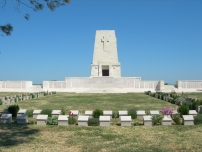| First Name: | William Alexander | Last Name: | GIBSON | |
|---|---|---|---|---|
| Date of Death: | 03/05/1915 | Lived/Born In: | Richmond-on-Thames | |
| Rank: | Private | Unit: | Australian 4th Battalion, 1 Brigade, 1st Division | |
| Memorial Site: | 1. Richmond-on-Thames Memorial 2. Lone Pine Memorial, Gallipoli | |||
Current Information:Age-25 83, Princes Road, Richmond
Gallipoli 1915 On 25 April, 1915, British, Australian and New Zealand forces landed on the Gallipoli peninsula. The plan was that these forces would soon defeat a demoralised Turkish army, knock Turkey out of the war, open up the Mediterranean to the Russian navy and threaten Austro-Hungary from the south. None of these things were achieved despite nine months of hard fighting in terrible conditions. It was an heroic failure. The 29th Division and the Royal Naval Division landed at five separate beaches around Cape Helles. Some were not defended, others were fiercely contested. Some ground was gained but within days the familiar pattern of trench warfare had set in. A similar pattern emerged further north where the Australian & New Zealand Army Corps (ANZAC) landed. The Turkish soldiers were much tougher fighters than had been given credit for and they were of course fighting an invasion of their homeland. The terrain, a series of steep rocky ridges and deep gullies made the fighting much more difficult and during the hot summer of 1915, the flies arrived in biblical proportions. Another seven British divisions were sent to Gallipoli during the summer but little or no progress was made. In the end, a new Commander was appointed and plans to evacuate the entire force were drawn up. By January 1916, all British, Australian and New Zealand forces had left Gallipoli, leaving only behind the dead, over 56,000 of them. On 25th April Australian and New Zealand troops landed on the Aegean coast at Ari Burnu. Their intended landing beach was further to the south on a long sandy beach but the currents brought them ashore at a small cove, known as ANZAC Cove, where the conditions were far from perfect. The soldiers from 9th 10th and 11th Battalions, 3 Brigade, 1st Australian Division were the first to land at this small cove and they were faced with steep cliffs and ridges up to around three hundred feet (91 m) in height. The plan was that they would advance across the peninsula, cutting off the Turkish troops in Kilitbahir, but the ruggedness of the terrain and the confusion caused by landing in the wrong place meant that they only got a few hundred yards inland. Later in the day they were joined by men from 1 Brigade (1st, 2nd, 3rd & 4th Battalions) 2 Brigade (5th, 6th, 7th & 8th Battalions) and the New Zealand Brigade (Auckland, Canterbury, Otago & Wellington Battalions) from the New Zealand & Australian Division, but even then little further progress could be made. Initially the Turkish defenders were thin on the ground but as they began to realise that this was the real landing and not a feint, more and more troops were hurried to the area and the ANZAC troops met stiff resistance. In the afternoon the Turks launched a counter attack which drove the ANZACs back in places but by the end of the day some 16,000 men had been landed and had secured a beachhead under two miles across and less than half a mile deep where they were digging in as best as they could. The lines had been drawn and from now on it was trench warfare. |
||||
| « Back to Search Results | ||||
| If you think any of the information shown here is incorrect, Click Here to submit your amends and comments | ||||




